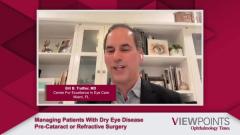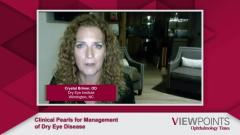
Managing Patients With Dry Eye Disease Pre-Cataract or Refractive Surgery
Kelly K. Nichols, OD, MPH, PhD, and Crystal Brimer, OD, provide their clinical advice on managing patients with overlapping eye diseases that need surgical treatment.
Episodes in this series

Transcript
Bill B. Trattler, MD: Let's jump to the scenario that we see a lot.I'm sure all of us see a lot, which is, the patient comes in with some blurry vision, they're not seeing well, they've been told they have a cataract, but they also have significant dry eye. Dr. Nichols, how are you managing those patients? And let's just imagine that this patient that's type A, they really want to get to their surgery ASAP, but they're seeing you for advice on how they can optimize their ocular surface as fast as possible, so they can go back to see their cataract surgeon.
Kelly K. Nichols, OD, MPH, PhD: Wouldn't that be great if a patient came in saying, “I'd like you to optimize my ocular surface so that I can get my cataract surgery?” But I think, ideally, they get taken care of wherever they come from.So, in the referring optometrist's office or the ophthalmology practice, they're all together, and it's managed ahead of time before they're evaluated for cataract. But oftentimes, we don't have that luxury. Then the question is whether or not you slow down their surgical timeline, or if you can do it within the number of weeks it might take for them to get to the point of having the surgery. So, there's the ideal and the real there. Certainly, you might not have the time to do a long-acting anti-inflammatory if they're going on quickly. But I think the important part is looking at the meibomian glands, because that probably causes as much, if not more, of an impact because it's the outermost lipid layer that is what is the refractive surface of the eye. If you can normalize the meibomian glands to some degree before cataract surgery, or any surgery for that matter, you have a better chance, of having a good outcome. So that's a good approach. And there are shorter versions of that, depending on what kind of practice you're in, I would love to send them all to Dr. Brimer's practice so that she could take care of them before they go on to cataract surgery. But it's important to look and be thinking,and our message should be to tell everybody as often as we can to look. Because that patient comes in saying that they have blurred vision, they aren't talking at all about dry eye symptoms. They are focused on getting their vision fixed, even if they have dry eyes. Unless you're really looking, you do miss it. They are an asymptomatic dry patient for the most part.
Bill B. Trattler, MD: Obviously, those are such great points. And just to share, Dr. Nichols, I'm a big fan of using hypochlorous acid spray for my patients prior to cataract surgery. Now I use it to help with MGD. I don't know if it does, but it may reduce the bacteria around the eyelid. So hopefully, that reduces the risk of infection. There's no clinical trial that's shown that, but theoretically, that's my hope. But thank you so much. It was such a great thought process on how we help our patients with cataracts that aren't seeing well. Let me ask Dr. Brimer, for patients that are coming for refractive surgery, they've gotten at least a consult, and they are a candidate in some ways, but their dry eye is too terrible to consider. How do you manage those patients? And again, imagine they're a little bit anxious to try to have surgery.
Crystal Brimer, OD: So, are they ruled out indefinitely or they've been sent back to rehab?
Bill B. Trattler, MD: Right. Their diagnosis says, “You're a minus four, you're going to be the perfect patient, but your dry eye tears aren't working. I want you to see an expert because I'm too busy to manage this. I know this great expert in dry eye and you're going to go right to her practice and she's going to fix you up ASAP.”
Crystal Brimer, OD: So, you're talking to a woman who has a huge portion of her dry eye practice as post-LASIK patients. So, I'm probably not going to steer them in that direction, but I'm not against it. If somebody has dry eye that puts them on the fence about being a candidate for LASIK, it's probably not a good long-term decision and we know that now. So hopefully, we're being discerning about who we allow to pursue that. But if I were trying and really giving them the benefit of the doubt and talking them through both sides, it would probably be procedure-based. Looking at what we've said all along, what's the underlying cause? And the way that I speak to them about this is, okay, we've got a boat, there's four holes in there. We've got to plug every hole, which means we've got to treat them simultaneously, or you're still going down. And if we come back and we're not winning in a category, then we go up to the next level and the next level of aggression. And it's not a trial-and-error thing with me. It's more of a, how far do we have to go? We add on, and we trade up, but I'm not taking away something. I gave them to trade it for something else. It's more of increasing the aggression and adding to it.
Bill B. Trattler, MD: I love that. That's a great point. And guess what? Based on your comments, we're going to switch the patient from LASIK to an ICL procedure to avoid any disruption to the accurate surface. Thank you, I appreciate your comment there.
Transcript is AI-generated and edited for clarity and readability.
Newsletter
Don’t miss out—get Ophthalmology Times updates on the latest clinical advancements and expert interviews, straight to your inbox.



























































